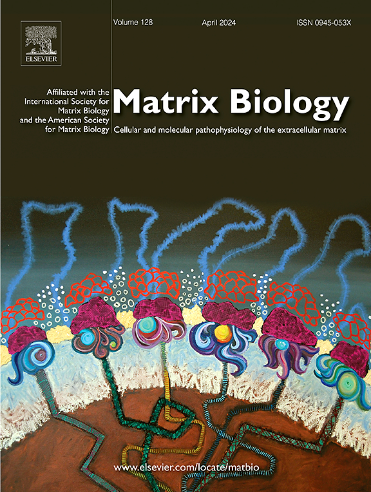Drosophila Col4a1 Glycine mutations highlight allelic heterogeneity and mechanistic pleiotropy
IF 4.8
1区 生物学
Q1 BIOCHEMISTRY & MOLECULAR BIOLOGY
引用次数: 0
Abstract
Collagen IV (Col4) is a heterotrimer containing a triple helical domain broken up by short interruptions. Mutation of Glycine residues within the Glycine-X-Y triple helical repeat leads to genetically dominant disease in humans that affects multiple organ systems. Mouse and cell culture-based models have revealed allelic heterogeneity, resulting in a range of Col4 secretion defects depending on the position of the mutation. However, genetic background also affects phenotypic severity, making it challenging to understand the precise underlying molecular mechanisms driving disease. Here, we characterize an allelic series of dominant temperature-sensitive Drosophila Glycine mutations to identify the potential molecular mechanisms driving phenotypic heterogeneity. Analysis of developmental viability at the non-permissive temperature revealed that mutations show a range of developmental lethality that is not correlated with their position within the triple helix nor with the degree of Col4 secretion defect. Backcrossing the series of fly lines led to increased lethality for almost all alleles, highlighting the presence of genetic modifiers, which paradoxically led to a reduction in secretion defects; this further suggests that defective secretion cannot explain the allelic heterogeneity in mutant viability. Analysis of the Col4 network surrounding the central nervous system (CNS) revealed that Glycine mutations can also affect basement membrane (BM) structure and alter its mechanical properties. Additionally, fluorescent tagging of a Glycine mutant variant showed that the mutated trimer is sufficiently secreted and can be incorporated into the network to dominantly affect BM organization. These data reveal that Col4 Glycine mutations can cause both secretion and direct BM network defects, suggesting that Col4-related pathologies may be mechanistically pleiotropic.
果蝇Col4a1甘氨酸突变突出了等位基因异质性和机制多效性。
胶原IV (Col4)是一种含有三螺旋结构域的异源三聚体,该结构域由短中断断开。甘氨酸- x - y三螺旋重复序列中甘氨酸残基的突变导致人类遗传显性疾病,影响多器官系统。基于小鼠和细胞培养的模型揭示了等位基因的异质性,导致Col4分泌缺陷的范围取决于突变的位置。然而,遗传背景也会影响表型的严重程度,这使得理解驱动疾病的精确潜在分子机制具有挑战性。在这里,我们描述了一系列显性温度敏感的果蝇甘氨酸突变的等位基因,以确定驱动表型异质性的潜在分子机制。在非允许温度下的发育活力分析表明,突变显示出一系列的发育致死率,这与它们在三螺旋中的位置无关,也与Col4分泌缺陷的程度无关。蝇系系列的回交导致几乎所有等位基因的致死率增加,突出了遗传修饰的存在,这矛盾地导致了分泌缺陷的减少;这进一步表明分泌缺陷不能解释突变体活力的等位基因异质性。对中枢神经系统(CNS)周围Col4网络的分析表明,甘氨酸突变也可以影响基底膜(BM)结构并改变其力学性能。此外,甘氨酸突变变体的荧光标记表明,突变的三聚体分泌充足,可以被纳入网络,主要影响BM组织。这些数据表明Col4甘氨酸突变既可以引起分泌缺陷,也可以引起直接的BM网络缺陷,这表明Col4相关的病理可能是多效性的。
本文章由计算机程序翻译,如有差异,请以英文原文为准。
求助全文
约1分钟内获得全文
求助全文
来源期刊

Matrix Biology
生物-生化与分子生物学
CiteScore
11.40
自引率
4.30%
发文量
77
审稿时长
45 days
期刊介绍:
Matrix Biology (established in 1980 as Collagen and Related Research) is a cutting-edge journal that is devoted to publishing the latest results in matrix biology research. We welcome articles that reside at the nexus of understanding the cellular and molecular pathophysiology of the extracellular matrix. Matrix Biology focusses on solving elusive questions, opening new avenues of thought and discovery, and challenging longstanding biological paradigms.
 求助内容:
求助内容: 应助结果提醒方式:
应助结果提醒方式:


